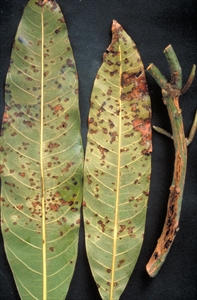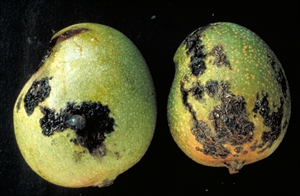Mango bacterial black spot
Pacific Pests, Pathogens and Weeds - Online edition
Pacific Pests, Pathogens & Weeds
Mango bacterial black spot (213)
Xanthomonas axonopus pv. mangiferaeindicae; previiously, known as Xanthomonas campestris pv. mangiferaeindicae (mangiferae-indicae).
Asia, Africa, North, South and Central America, the Caribbean, Oceania. In reported from Australia and New Caledonia. CABI says that reports from several countries, including New Caledonia, are not supported by literature or specimen records (http://www.cabi.org.ezproxy.library.uq.edu.au/cpc/datasheet/56950).
Mango, and also cashew.
On the young leaves, the bacteria cause black, angular greasy spots between the veins, often with yellow halos. The spots merge, destroying large areas of the leaves, and as they age they turn grey and crack.
On the fruit, black oval to irregular raised spots develop, with greasy margins. The spots may join together, crack, and sap oozes out that is full of bacteria. The spots are only skin deep, but they affect quality, and lead to the fruit being rejected or sold for a low price.
Flowers are also infected, as well as the leaf stalks and stems. The cankers that occur on the stems can lead to shoot-tip dieback.
The spots are different from those made by the anthracnose fungus, Colletotrichum gloeosporioides, and those of Stigmina (see Fact Sheet no. 09). The spots are darker, more angular, and have raised margins. However, both anthracnose and bacterial black spots can occur together on the fruit. When this happens, large deep rots are possible.
Spread is in wind-blown rain, water splash and by insects. The bacteria enter through natural openings or wounds in the leaves and fruit. Long distance spread is on nursery trees for new plantings. The disease can be severe in both high and low rainfall areas as dews and wounding are important in the development of the disease. Cyclones provide the perfect conditions for the disease to spread.
Mango bacterial black spot is a very serious disease of mango. In infected orchards, chemical control is difficult and on some farms in Australia, for example, 90% of the fruit has had to be thrown away because the spots on the fruit make them unacceptable to the market.
Look for the spots on the young leaves which are angular, bordered by the veins, black with slightly raised margins, and yellow haloes. Look for the fruit fly-like 'sting' on the fruits and, later, raised black spots with greasy margins that crack releasing bacterial ooze. Look also for stem cankers.
QUARANTINE
As this disease is not recorded in Fiji, Samoa, Solomon Islands and Tonga, biosecurity authorities should consider the potential pathways for entry.
CULTURAL CONTROL
Before planting:
- Use local sources of planting material - rootstocks and scion wood - that are known to be free of disease.
- Make nurseries for raising rootstocks or grafted trees away from mango plantations to avoid contamination.
- Select a site that is protected from winds, or establish good windbreaks. The disease seems much worse on trees affected by wind damage. However, the site should have good sunlight and air movement so that leaf wetness is minimal after rain.
During growth:
- Preferably, avoid sprinkler irrigation and use drip irrigation to avoid spreading the disease when watering plants in the field.
- Prune trees so that foliage is not too dense, especially at the centre of the trees, and make sure that limbs do not rub on each other. Damage, even superficial, allows the bacteria to enter more readily. Sterilize pruning tools with bleach after pruning each tree.
- Harvest by clipping the fruit stalks; do not tear the fruit off the trees.
After harvest:
- Prune after harvest, removing sources of infection; collect and burn the cuttings.
- Do not market fruit that show bacterial black spot to avoid spreading the disease.
RESISTANT VARIETIES
Most of the commercial varieties are susceptible, but some have tolerance, so check with commercial nurseries.
CHEMICAL CONTROL
In commercial plantations, use copper fungicides (every 2-4 weeks), except during flowering when mancozeb should be used instead.
____________________
When using a pesticide, always wear protective clothing and follow the instructions on the product label, such as dosage, timing of application, and pre-harvest interval. Recommendations will vary with the crop and system of cultivation. Expert advice on the most appropriate pesticide to use should always be sought from local agricultural authorities.
AUTHOR Grahame Jackson
Information from Diseases of fruit crops in Australia (2009). Editors, Tony Cooke, et al. CSIRO Publishing; and from Chin D et al. (2010) Field guide to pests, beneficials, diseases and disorders of mangoes. Northern Territory Government, Department of Resources, Australia. (https://dpir.nt.gov.au/__data/assets/pdf_file/0006/227832/mango_field_guide.pdf). Photos 1&2 Kohler F, et al. (1997) Diseases of cultivated crops in Pacific Island countries. South Pacific Commission. Pirie Printers Pty Limited, Canberra, Australia.
Produced with support from the Australian Centre for International Agricultural Research under project PC/2010/090: Strengthening integrated crop management research in the Pacific Islands in support of sustainable intensification of high-value crop production, implemented by the University of Queensland and the Secretariat of the Pacific Community.





